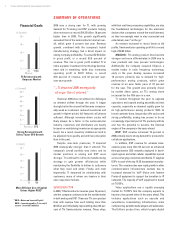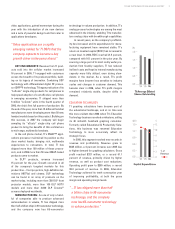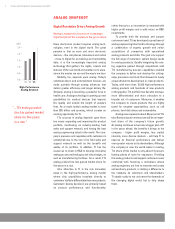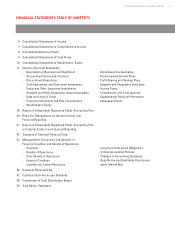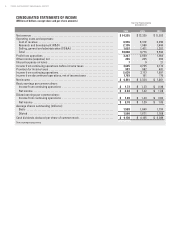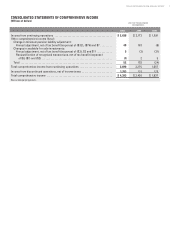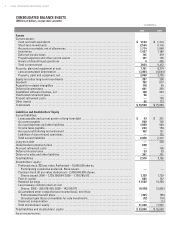Texas Instruments 2006 Annual Report Download - page 14
Download and view the complete annual report
Please find page 14 of the 2006 Texas Instruments annual report below. You can navigate through the pages in the report by either clicking on the pages listed below, or by using the keyword search tool below to find specific information within the annual report.
TEXAS INSTRUMENTS 2006 ANNUAL REPORT
1212
remeasured at the appropriate daily rate of exchange. Net currency exchange gains and losses from remeasurement are
charged or credited on a current basis to other income (expense) net.
Derivatives: We use derivative financial instruments to manage exposure to foreign currency and interest rate risk. We
enter into certain foreign currency derivative instruments that do not meet hedge accounting criteria. These instruments
are primarily forward currency exchange contracts that are intended as economic hedges to minimize the adverse earnings
impact from the effect of exchange rate fluctuations on our non-U.S. dollar net balance sheet exposures. Gains and losses
from these forward currency exchange contracts are credited or charged on a current basis to other income (expense) net.
With respect to long-term debt and its associated interest expense, we may utilize interest rate swaps designated as fair
value hedges to change the characteristics of the interest rate stream on the debt from fixed rates to short-term variable
rates. The net effects of interest rate swaps are included on an accrual basis in interest expense. There is no hedge
ineffectiveness related to these swaps.
We do not use derivatives for speculative or trading purposes.
Revenue Recognition: Revenue from sales of our products, including shipping fees, is recognized when title to the products
is transferred to the customer, which usually occurs upon shipment or delivery, depending upon the terms of the sales order.
Estimates of returns for product quality reasons and of price allowances (calculated based upon historical experience,
analysis of product shipments and contractual arrangements with customers), are recorded when revenue is recognized.
Allowances include discounts for prompt payment, as well as volume-based incentives and special pricing arrangements.
In addition, allowances for doubtful accounts are recorded for estimated amounts of accounts receivable that may not be
collected.
Revenue from sales of our products to distributors is recognized, net of allowances, based upon delivery of the products to the
distributors. At the time of delivery, title transfers to the distributors and payment from the distributors is due on our standard
commercial terms; payment terms are not contingent upon resale of the products. Credit allowances for the distributors are
calculated based on historical data, current economic conditions and contractual terms. For instance, we sell our products to
distributors at standard published prices, but we may grant price adjustment credits to distributors in response to individual
competitive opportunities they may have. To estimate allowances for this type of credit, we use statistical percentages of
revenue, determined quarterly based upon recent historical adjustment trends.
We also provide distributors an allowance to scrap certain slow-moving or obsolete products in their inventory, estimated as
a negotiated fixed percentage of each distributor’s purchases from us. In addition, if we publish a new price for a product that
is lower than that paid by distributors for the same product still in distributor on-hand inventory, we may credit the distributors
for the difference between those prices. The allowance for this type of credit is based on the identified product price
difference applied to estimated distributor on-hand inventory of that product.
We believe we can reasonably and reliably estimate allowances for credits to distributors in a timely manner.
Our contractual agreements with our intellectual property licensees determine the amount and timing of royalty revenue.
Royalty revenue is recognized when earned according to the terms of the agreements and when realization of payment is
considered probable by management. Where royalties are based upon licensee sales, we recognize royalty revenue upon
the sale by the licensee of royalty-bearing products, as estimated by us based on historical experience and analysis of annual
sales results of licensees. Where warranted, revenue from licensees may be recognized on a cash basis.
Shipping and handling costs are included in cost of revenue.
Advertising Costs: Advertising and other promotional costs are expensed as incurred. This expense was $190 million in 2006,
$126 million in 2005 and $92 million in 2004.
Impairments of Long-lived Assets: Reviews are regularly performed to determine whether facts or circumstances exist that
indicate the carrying values of fixed assets, intangible assets or capitalized software licenses are impaired. We assess
the recoverability of assets by comparing the projected undiscounted net cash flows associated with those assets to their
respective carrying amounts. Impairment, if any, is based on the excess of the carrying amount over the fair value of those
assets. Fair value is determined by available market valuations, if applicable, or by discounted cash flows.
Income Taxes: We account for income taxes using an asset and liability approach. We record the amount of taxes payable
or refundable for the current year and the deferred tax assets and liabilities for the future tax consequences of events that
have been recognized in the financial statements or tax returns. When it is more likely than not that some portion or all of the
deferred tax assets will not be realized, a valuation allowance is recorded.


